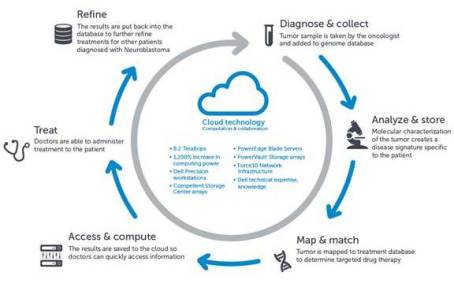Cloud computing is a key component on the path to personalised medicine
James Coffin PhD, Vice President and General Manager, Dell Healthcare and Life Sciences
18 October 2012
When scientists embarked on the 13-year journey to map the human genome in 1990, they envisioned a future where the knowledge of DNA would aid in the diagnosis, treatment and even prevention of thousands of diseases and disorders.
Fast forward to 2012 and that dream is closer to reality thanks to ongoing advances at the nexus of high-performance computing and genomics research. Though we have yet to identify cures for diseases such as cancer and AIDS, personalised treatments based on a patient’s molecular makeup — as opposed to a “one size fits all” approach — are optimising and extending lives.
An essential element to moving forward in the field of personalised medicine is cloud computing technology. The cloud is a future-ready infrastructure that makes it possible to create a healthcare “system” for applied medical research. This system — in which information is secure but accessible to those who need it for analysing, selecting, and administering treatments — streamlines administration, enhances the quality of care and ultimately supports personalised medicine.
Targeting paediatric cancer
The world’s first personalised medicine clinical trial for paediatric cancer conducted by the Neuroblastoma and Medullobastoma Translational Research Consortium and supported by The Translational Genomics Research Institute is using a secure cloud-based IT infrastructure supplied by Dell. In addition to increasing TGen’s gene sequencing and analysis capacity by more than 1,200%, the cloud is also improving collaboration among the researchers and medical professionals working on the trial by allowing them all to access the same massive amounts of information, analysis and results regardless of where they are physically located.

Accelerating treatments for paediatric cancer
with cloud technology
The cloud infrastructure — both a high-performance computing resource and a data exchange/collaboration resource — is being used to investigate new technologies that accelerate genetic analysis and identification of targeted treatments for individual neuroblastoma patients. A process that at one time took months to complete (and often required overnight shipment of hard drives from one clinical site to another) has been reduced to just days — meaning that patients can begin receiving effective, personalised treatments that much sooner.
We’re bridging the gap between science, medicine and technology to provide a real-time knowledge repository of the latest findings on the most effective treatments for paediatric oncologists to use globally. Imagine the possibilities. Such cloud computing platforms could support complex biomedical knowledge exchanges between healthcare providers, research centres, clinical genomics and molecular diagnostic vendors and pharmaceutical researchers interested in participating in personalised medicine trials targeting many other diseases and disorders.
Cloud considerations for healthcare
Every healthcare organisation will have its own unique path to cloud adoption, but more and more providers are beginning to see the advantages of moving to the cloud as they work to cut costs, enhance quality, comply with ever-changing regulatory demands and extend their existing IT capabilities. Payers and life sciences companies are seeing the benefits too as they streamline processes to more efficiently manage data and drive innovation.
Privacy and security are of paramount concern in healthcare. Unlike a public cloud, a healthcare cloud must have several key features, including administrative, physical and technical controls to meet the rigorous needs for security, privacy, reliability and compliance of healthcare enterprises.
A secure healthcare cloud should be limited to healthcare tenants only and should:
- be configured to support HIPAA compliance;
- be hardened and highly available for guaranteed service levels;
- include logically partitioned networks, compute and storage layers;
- provide data management features, including policy driven data access and deletion;
- provide interoperability to ease integration; and
- provide mobility for users through secured mobile devices.
The future of healthcare
In the not-so-distant future, IT will be leveraged not only for
documentation and exchange, but also for expert diagnosis and
analytics. Because of the amount of data that will be generated,
stored and analysed, the cloud can speed computational processes,
manage and store the resulting data, and provide a forum for
analytics and global collaboration.
Once we tap the digital
data generated by electronic medical records, imaging and genomics
research for intelligence, the possibilities for innovation and
health advancement are unlimited.